Getting Into The Spirit Of Rush
By Götz Küehnemund,"Rush Fan Mag" supplement to Metal Hammer, April 3, 1989, transcribed by pwrwindows
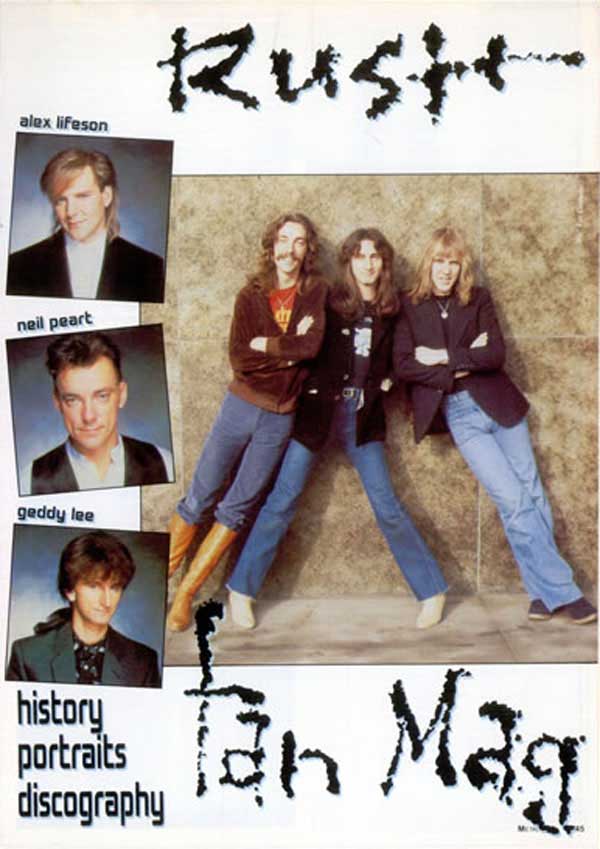
There are some bands who create a piece of rock history with every one of their LPs - and large parts of the record buying public don't even realise what they're missing. One of these bands is Rush, often dubbed the 'biggest underground act in the world'. The band long reached platinum status at home in Canada as well as in the US, but in Europe Rush have generally had to rely on their live shows for success. Although Geddy Lee (bass/vocals/synthesiser), Alex Lifeson (guitar/synthesiser) and Neil Peart (percussion) have the reputation in this part of the world for being great musicians, they still haven't reached the status they deserve. Sad, because other rock bands, despite being nowhere near as good at playing and composing have gained a lot more popularity in Europe. Over the following twelve pages we trace the bands' amazing 22 year history. It's a great read. And if you've never got into Rush before - now you'll know what you've been missing!
The First Chapter:
1968 to 1976
Alex Lifeson, the son of Yugoslav immigrants and proud owner of a cheap electric guitar, formed the amateur band The Projection in Spring 1968 with his drum crazy school pal John Rutsey, and they were joined soon afterwards by bassist/singer Jeff Jones. The band covered various Cream songs, and earned their first pennies occasionally playing clubs and youth clubs around Toronto. As it was out of the question for the band to buy their own sound system, they borrowed the necessary amps from local musician friends. One of these friends was a guy called Gary Lee, generally known as 'Geddy' be-cause of his Polish/Jewish roots, and a bassist rarely seen playing anything other than a Yardbirds bass line.
In September of the same year The Projection had renamed themselves Rush - Geddy received a phone call from Alex, who was in deep trouble. Jeff Jones was nowhere to be found, although a gig was planned for that evening. Because the band badly needed the money, Geddy helped them out, not just providing his amp, but also jumping in at short notice to play bass and sing. He was familiar with the Rush set already, as they only played well-known cover versions, and with his high voice reminiscent of Robert Plant, he complemented the band's blues rock perfectly. The reviews for the evening were great! After the gig there was no question: Jeff was going to have to find him-self a new band. From that day on, Geddy was bassist and singer with Rush. But the marital bliss don't last long...
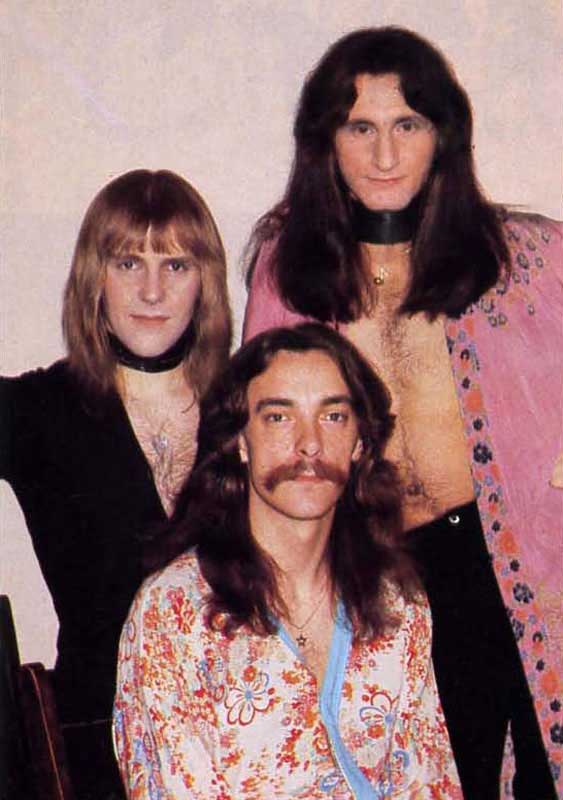
Over the Christmas period of '68, Rush expanded with the addition of a keyboarder called Lindy Young, who proved a multi talent and also took over a few vocal parts during the next few months. Geddy was sacked in May 1969 and replaced by bass player Joe Perna. The change in line-up also meant a change in the bands' name: Rush turned into Hadrian.
Geddy tried his luck with the rhythm 'n' blues combo Ogilvie, who shortly afterwards also changed their to Judd, splitting up in September of the same year. John and Alex, who were in Hadrian, contacted Geddy again, and the three of them decided to reform Rush but without; Lindy Young, who had started his university course by then. In Autumn 1969 the first Led Zeppelin LP was released, and it hit Alex, Geddy and John like a hammer. Rush shut themselves away in their rehearsal rooms, turned up the amp and discovered the fascination of heavy metal"?
The following months were going to prove tough for the three young musicians who were either still at school or at work. In their spare time, they played Zeppelin, Who and Cream songs, at the same time writing their own numbers and improving their live routine in the small local clubs.
In February 1971, Rush started hunting for a second guitarist, because their music had become too heavy for a single guitarist. The job was given to a guy called Mitch Bossi, who only stayed in the band for a few months before leaving. Geddy, Alex and John couldn't find a suitable fourth man, so they carried on strumming through the bars as a trio -and started to celebrate their first successes. More and more frequently it was the club owners who contacted the band sometimes offering them quite decent fees; they were even hired for larger gigs and had to stop complaining about lack of work!
Rush were a regular sight down the local clubs by 1972, and could at last afford to buy themselves some new instruments, Their live set included songs like 'Working Man' and 'In The Mood`, songs that would be later also be included on the debut LP.
Buddy Holly
It was gradually time to go into the studio and record some demos, to offer around the record companies for possible release; after all, the boys have gained loads of experience during the last few years, and they know they could break through the confines of the home town if they released just one record.
A few months later, we've reached the year 1973, the time was right: The band scraped together the necessary money to rent the Eastern Sound Studios in Toronto, and recorded two songs 'Not Fade Away' (a cover version of the Buddy Holly Oldie) and 'You Can't Fight It' (their own composition). They hoped a record company would show some interest and release the recordings as a single; But Geddy, Alex and John didn't have any luck in the beginning. London Records were prepared to distribute the single but only under the condition that the band form their own label and take over all production costs.
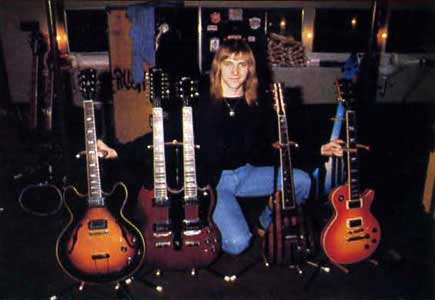
The band decided to take the plunge, so they founded Moon Records, The single was pressed. but didn't sell too well. They still weren't in the best position from which to approach a major company, and so the band found themselves forced into the position of grabbing the initiative themselves.
Rush returned to the studio in 1973, this time recording eight songs and London Records were approached to distribute them. The LP was called simply 'Rush' and released in January 1974 as a limited edition of 3,500 copies on Moon Records Label. Although the band still lacked the money for a proper sleeve after all the expensive production costs, and despite the unprofessional packing, the first LP sold surprisingly well. It sold so well in fact, that the record had to be re-pressed, managing to sell 5000 copies during the first few months! Cliff Burnstein, who worked in the promotional department of Mercury records also recognised the bands' potential and played the album non-stop for weeks. Cliff managed to convince Irwin Steinberg who was director of the US company of the trios abilities, and the deal was completed shortly afterwards: Rush signed a deal with industry giants Mercury!
The LP, still recommended listening these days de-spite the poor production (after all it does include the Rush classics like 'Finding My Way', 'Working Man' and 'In The Mood'; tracks that have stayed part of the regular live set for years), was re-released in August 1974 through Mercury. The bands' first US tour started exactly two weeks later, supporting bands like Uriah Heep, Nazareth. Rory Gallagher, Kiss, Hawkwind and Manfred Mann through the arenas. But here was another line-up reshuffle in Rush first; John, a diabetes sufferer, couldn't get accustomed to the idea of being on the road for months on end and left the band. Geddy and Alex, forced to find an adequate replacement within a few days had good news as well bad news: A guy called Neil Peart, who used to play in a local band called Hush, introduced himself to the band, and was accepted on 29th July '74, on Geddy's 21st birthday. Neil, who was a much better musician than his predecessor, turned out to be an excellent lyricist, and developed into an irreplaceable part of the band. Rush had found their ideal line-up, and were armed for big success.
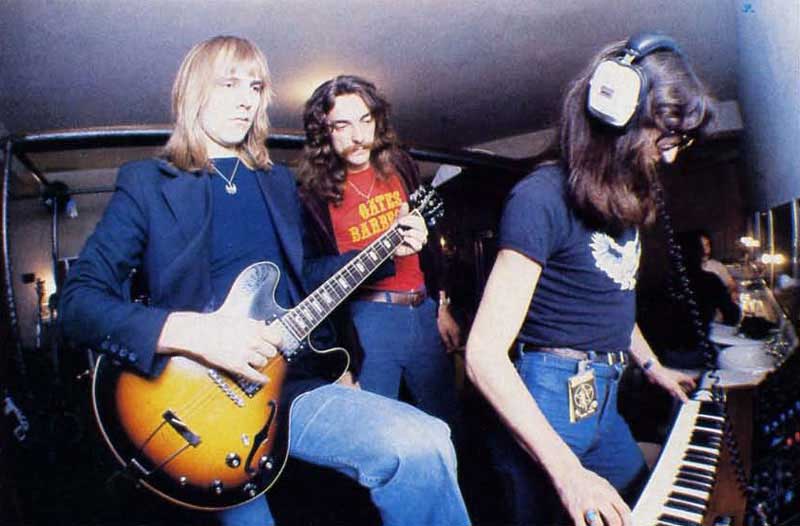
The US tour started on the 14th August in Pittsburgh. The hall was virtually sold out; Neil celebrated his debut in front of 12,000 fans! A large proportion of the audience had come to see the respective headliners; but Rush still held the ground at most of the shows and were even offered their first TV appearances in conjunction with the shows. The first stone had been laid...
The trio, by now grown together to a close unit went back to Toronto to start composing new songs for their second album as soon as the US tour was over. The title of the LP was 'Fly By Night' and was a big improvement to the debut and sounded a lot more independent. Neil's influence was not to be overlooked, although he had only written the lyrics, But because the band's music was closely connected to the lyrics and vice versa, 'Fly By Night' was very different from the debut LP. The highlights of the record are the opening track 'Anthem', the title track and especially the nine-minute track 'By-Tor and The Snow Dog', a story divided in to four parts, giving the listener a taste of the band's further development.
Steel
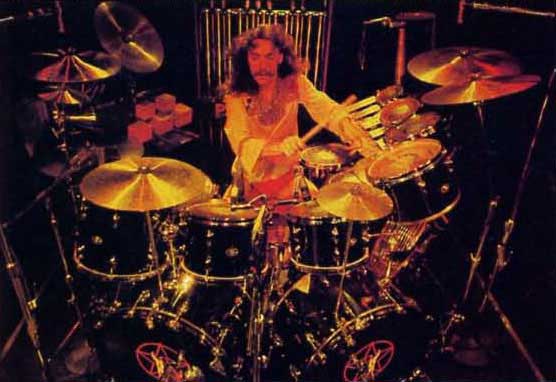
When the LP was released in February 1975, Rush were back on tour again this time supporting Kiss and Aerosmith. Although they were still playing support slots in the States, the band were headlining and selling out small halls at home in Canada. In Toronto for example approx. 3000 fans came to see the band and Rush received their first golden award that year, for 'Fly By Night' in their home country (50,000 sold copies).
In July '75. Geddy, Alex and Neil went back to the Toronto Sound Studio to start work on their third album 'Caress Of Steel'. Terry Brown, the man who produced the first two LP's, was once again responsible here, and he completed his job as well as on the first albums. The record included two long conceptual tracks: 'The Necromancer' (in contents this track was a continuation of 'By-Tor And The Snow Dog' and strongly influenced by assorted fairy tales and fantasy stories) and 'The Fountain Of Lamneth'. The latter track took up a whole side on the album, and it was basically about the quest for the meaning of life. Although the quality of the record is indisputable, (as far as I'm concerned, Caress Of Steel, 2112 and 'Moving Pictures' are the trio's best studio albums), when the record was released in September '75 it didn't sell very well. The following US-tour lasting three and a half months didn't sell as well as the band had expected. Were Rush entering their first crisis?
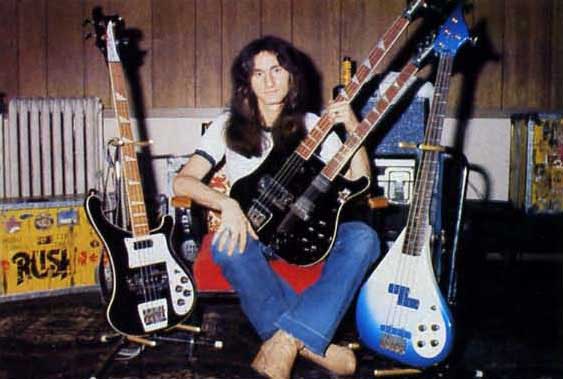
Instead of switching back a gear and concentrating on the shorter simpler songs, the three Canadians took a risk when they released '2112' in March 1976 as it was an obvious continuation of 'Caress Of Steel'. The title track (it was later available as a comic in the Marvel series 'The De-fenders') was sub-divided in seven closely connected sections, once again taking up a whole side of the LP, and telling the story of a fantasy set in the year 2112. The story is about a galactic war after which the planets are ruled by priests ('The priests of the temples of Syrinx') who control the arts, all expressive creativity and individual thinking by computer. The hero of the story finds an old guitar and learns the magic of music. The priests see their position of power threatened by such an instrument symbolising human freedom, and forbid their discoverer to carry on using it. He then returns to the place where he found the guitar, and dreams of a world where there are no restrictions. He wakes up and realises the world has ceased to exist, so he kills himself.
On the b-side of the LP there's a song called "Tears", a track containing keyboard parts played by a guy called Hugh Syme. For the first time in the history of Rush a guest musician was involved in production, and apart from playing on the album he was also responsible for the cover artwork.
'2112' beat all expected sales figures in the first few weeks after release, and it sold better than all three previous albums put together. The band experienced the same amount of success during their fourth tour, during which Rush headlined medium to large halls even in the States.
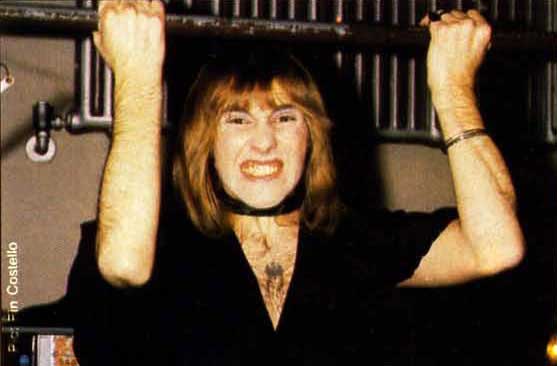
Because of the surprisingly well received tour the logical consequence was to release a live album in between recording the next studio album. 'All The World's A Stage', a title taken from a Shakespearian play, was recorded on the 11th, 12th, and 13th of June in the Massey Hall in Toronto and released on 29th September 1976 as a double LP. The album is still regarded as one of the best live albums in the history of hard rock with its highlights like 'Anthem', 'Fly By Night', 'Working Man`, 'By-Tor & The Snow Dog' and extracts from '2112' highly regarded to all lovers of sophisticated music. 'All The World's A Stage` was the long awaited breakthrough for Rush in the States and Canada, and it completed the first chapter of the bands' history with the threesome shown from their original side - rough, genuine and restricted to the basic elements of their sound (guitar, bass, drums, vocals).
The Second Chapter:
1977-1981
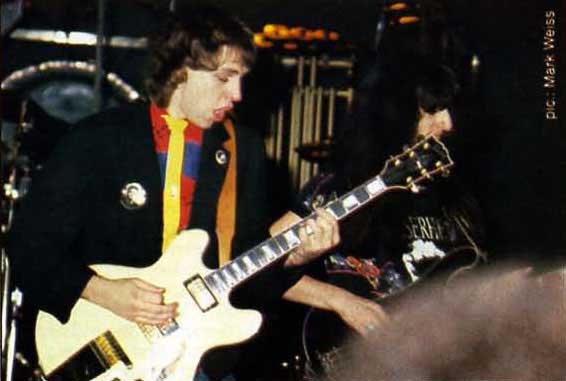
After a further US tour as special guest with Blue Oyster Cult and individual headlining shows in front of 5,000 - 7,000 fans, the trio were presented with gold awards for 'Caress Of Steel' and 'Rush' in Canada. So as not to stagnate musically, and accomplish further aims, Rush started using more keyboards after 'All The World's A Stage' tour was over. But despite using another instrument, they decided not to involve a fourth musician, certain the problem could also be solved by the three original members of the band. So they solved the problem by transferring some of the bass parts onto pedals, operated both by Geddy and Alex. Geddy made sure he could also operate the keyboards. Alex also played a double-necked guitar while Neil discovered new percussion instruments. Rush had reached a new stage in their development, and this was marked by the numerous technical experiments.
On the LP 'A Farewell To Kings', the first to be produced in England, you can easily hear the musical developments. The record, with its highlights in the songs 'Xanadu', 'Closer To The Heart' (The original working title for the album) and 'Cygnus X-l' (another monumental track lasting over ten minutes), was released in September '77. Soundwise it was also more mature than the predecessor. Although Rush moved away slightly from their heavy rock roots with the LP 'A Farewell To Kings', they emerged as gifted musicians, who had at last found their own and unique style.
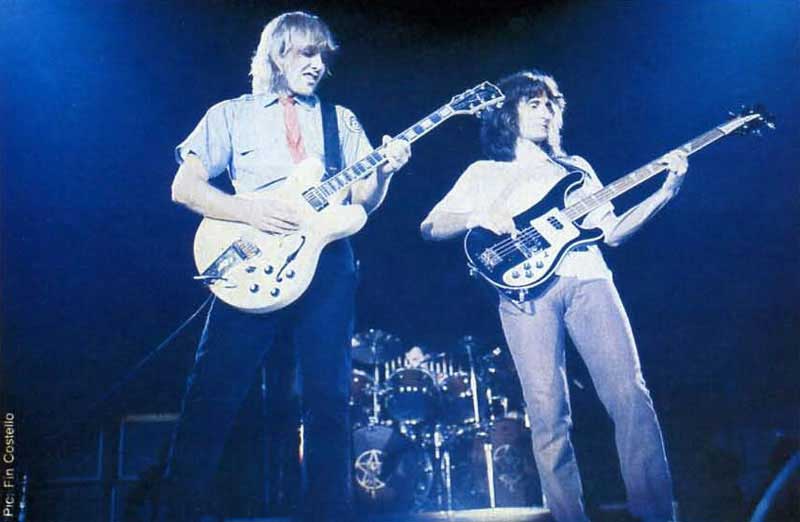
While still recording the LP, the band embarked on their first European tour, taking them through England, Sweden, Germany and Holland. Although Rush were less successful over here in Europe, than in Canada and the States, the shows went down well.
The trio returned to America in September and toured as headliners through the largest cities. The tickets sold like hot Cakes, and extra shows had to be organised in most of the cities they toured. The States had been conquered completely by November: Rush received Gold LP's for '2112', 'All The World's A Stage' and 'A Farewell To Kings', each one of which had sold more than 500,000 copies.
The band didn't allow themselves a break, and carried on touring North America during early '78, before the second planned UK tour in February, this time completely sold out. Although Geddy and Alex were restricted on stage, because with the addition of keyboards and bass pedals they had to operate quite a few instruments at the same time, that didn't affect the show as a whole. Quite the opposite: The fans weren't sure at first what they should be looking at, not believing that the incredibly complex sound could have been created by just three musicians!
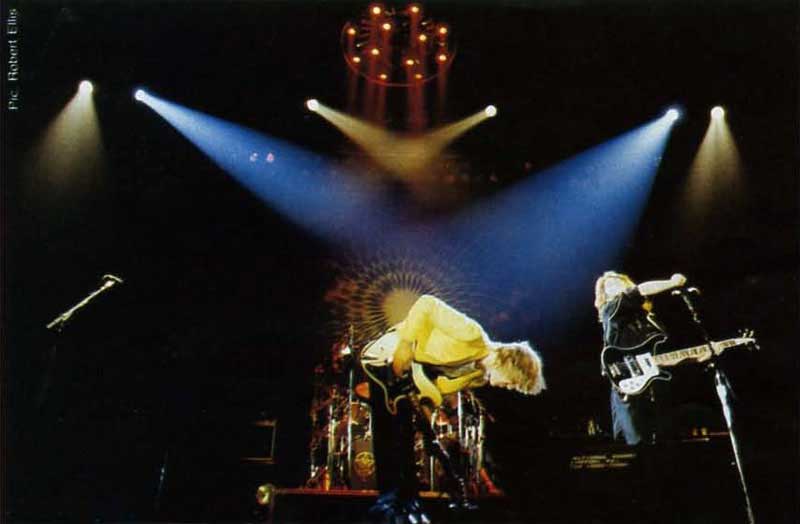
At last the European media were forced to acknowledge the band, and they received widespread coverage. Most journalists loved the trios' genius - with one exception: A writer on the weekly paper NME described Neil Peart as a radical right-wing lyricist, after interviewing him, and put the band in the completely wrong light. Rush had never expressed political statements, let alone represent fascist ideologies. Geddy was particularly hurt by this un-true statement; his parents had been deported to a concentration camp during the war, only just avoiding death by the nazis.
Shortly afterwards the bands first three LP's 'Rush', 'Fly By Night' and 'Caress Of Steel' were released as a triple album under the title 'Archives' in the States, Canada and England. During the months of June and July of '78 Alex, Geddy and Neil went into the Rockfield Studios in Wales, to produce their new LP 'Hemispheres'. The record demanded more of the musicians than anything had before, and it was released in October. It involved the Rush-classic 'The Trees' and the second part (about 18 minutes long) of the story that had begun on 'A Farewell To Kings'. 'Cygnus X-1 Book II/Hemispheres'. Neil described a world dominated by two Gods Apollo and Dionysus. Apollo symbolises reason and rational judgment. Dionysus symbolises feeling and creativity. Both stand in contrast to one another, and fight for the power over the people, until Cygnus, the character at the centre of the story, creates a balance. The statement in this parable was typical for Rush: One of Neil's main matters of concern was to explain to the audience that humanity was only capable of withstanding a careful balance of extremities.
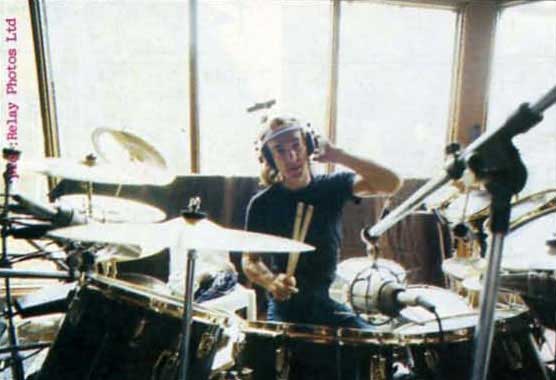
The 113 dates of the 'Hemispheres' tour started with the release of the LP in October '78 and only ended in June of the following year. During the last two months, Rush played in Great Britain, Germany, Norway, Sweden, Belgium, Finland, Denmark, Switzerland and Holland. It was during the US shows, that the trio put more emphasis on the visual effects and presented their video show to the fans for the first time. During the following years this would develop to an important trademark of the band.
RADIO
'Permanent Waves', the eighth Rush album (with-out counting the 'Archives' compilation), was released on the first day of the new decade, January lst 1980, and sounded more synthesiser orientated. The addition of new technologies combined with the ever present hard rock elements created a sound pattern, fulfilling not only a musical function but also affecting the lyrical content: The basic theme was that science is not anti-nature, but can complete the latter if applied correctly. This is the statement in the song 'Natural Science', the closing track off the LP. 'Permanent Waves' also included a hit single in the shape of the opening number 'The Spirit Of Radio' and charted high in America, Canada and England.
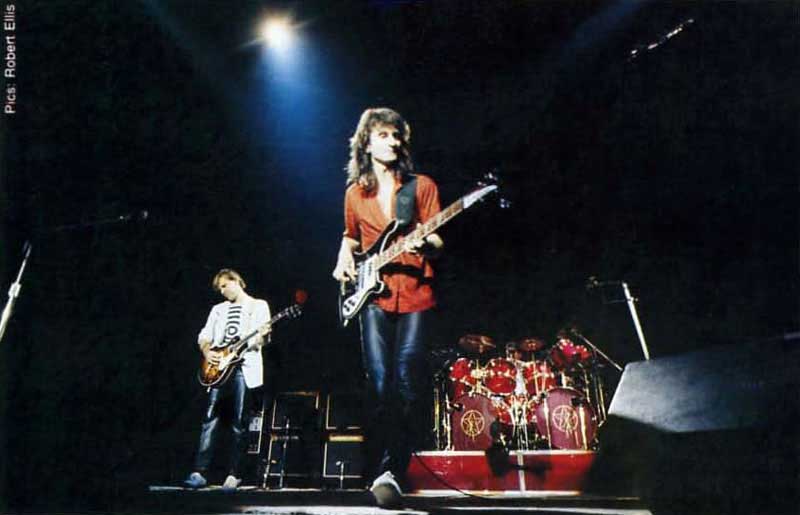
The bands' most costly world tour to date started in January, presenting Geddy, Alex and Neil at an all time creative high. Various shows were cut for another live album; the release of the recording was however delayed to a later date, because the Canadians had already accumulated enough material for a new album. Rush shut themselves away in the studio in October and November and produced their probably most successful album to date, 'Moving Pictures', with Terry Brown. The record that included such exceptional compositions as 'Tom Sawyer', 'Witch Hunt', (a very gloomy song and the third part of the concept story with the title 'Fear', elaborated on the following LPs) and 'YYZ' (an instrumental track with the rhythm based on morse code), was released in February 1981 and is an absolute MUST for every rock fan!
The next tour kicked off that month in North America, and it was a true triumph for the band. Although the dates continued for a period of 'only' half a year, Rush reached a larger audience than ever before. In the States they headlined large arenas only, during which they received three platinum honourings for '2112', 'All The World's A Stage' and 'Moving Pictures', an honour no other band achieved that year. Recordings from various concerts were mixed and together with extracts from the 'Permanent Waves' tour from October '8l were released as the live double album 'Exit... Stage Left'. After the massive tour of the US, the band took a short break before returning to Europe in Autumn, again greeted with open arms. At the same time they released their first live video, also called 'Exit...Stage Left'. and this was also an interesting insight into the Canadians complicated light show.
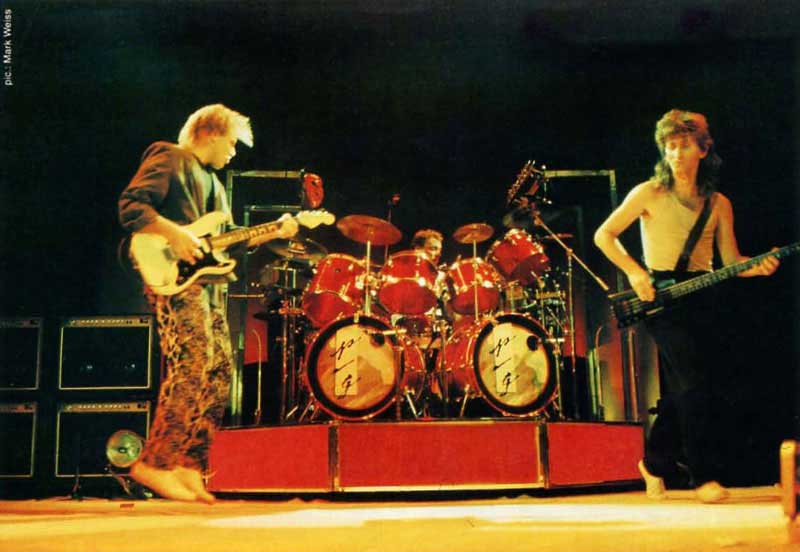
'Exit...Stage Left' (the album) differed from its predecessor 'All The World's A Stage' in that it recorded not only one, but two tours. The material didn't sound as rough as it had done in the past, it was more thought-out and mature. All three musicians had improved their playing abilities the keyboards had established themselves as a regular feature of the music. The cover of the double LP composed of various motives from previous album sleeves, signalising the completion of the second chapter in the history of Rush: Geddy, Alex and Neil had widened their musical spectrum with the implementation of new instruments and modern technology, and allowed elements of other styles to flow into the originally very basic rock songs like jazz, ska and even reggae. The period ending with 'Exit...Stage Left' was particularly notable by the trio's further technical development.
Just before the second double live LP was released, Mercury re-released the compilation LP 'Rush Through Time', that had first been available in 1978, with the highlights like 'Fly By Night', 'Bastille Day', and 'Closer To The Heart' ranging from the time between '75 and '77.
The Third Chapter:
1982 to 1989
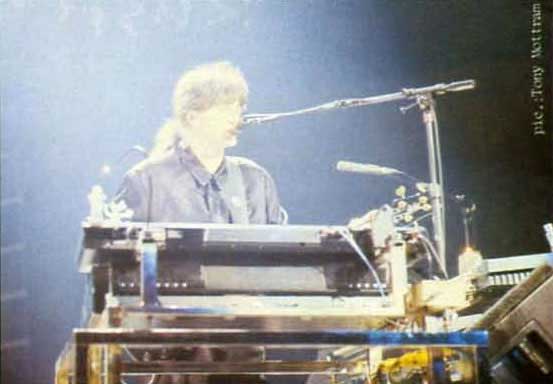
Rush spent the first few months of 1982 in Canada, spent working on material for the ninth studio album. Songs like 'Subdivisions', 'Digital man' and 'The Analog Kid' were written during this period, the tracks seemed particularly catchy for Rush's standards with more synthesizers than usual.
The new LP was titled 'Signals', and it was recorded from April until July in Quebec, Canada before it was finally released in late summer of '82. The compositions were more direct, and arranged more tightly than in the past, and they relied on simple catchy tunes that branched out less. The lyrics had also changed: Whereas previously Neil had been heavily into Sci-Fi and fantasy, and had decorated his lyrics with numerous metaphors. he was now writing more realistically and expressing himself clearer. lnstead of embracing worldly philosophies, he dealt with problems between people and every-day occurrences. At the same time the Rush lyrics had lost none of their usual romanticism and poetry.
"The development of the lyrics went hand in hand with my personal development as a person." Neil explained to me in an interview earlier this year. "I used to try and break out of reality and build myself a fantasy world. The result were long stories. leading to the complicated musical arrangements. I also looked into classical literature and poetry and tried to incorporate them in my lyrics. l've now begun to become more fascinated with the world going on around me. l've learnt to express daily occurrences with more simple words, so the fans can identify themselves more with the lyrics."
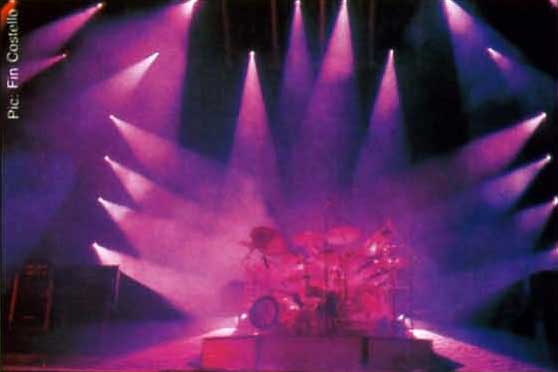
Apart from the already mentioned songs, 'Signals' also included 'The Weapon', the second part of the 'Fear' trilogy that had started with 'Witch Hunt' and the hit single 'New World Man'. Personally I find the album too keyboards orientated at times, with some tracks showing a lack of energy in which Rush had previously excelled. The LP still sold as well as expected, as had the others before it, and when the next tour took off in September, it was a complete success. The band offered the enthusiastic fans their most complicated show yet, including a giant light show with laser and video effects. Rush were on the road in Europe during May '83. This time they easily filled massive arenas all over the Continent, and even had to add extra concerts on to some towns. The trio spent the following months looking for a new producer for the next studio album. Terry Brown had been responsible for Rush's production until then. But Geddy, Alex and Neil were the opinion that it was time for a change, so they contacted Peter Henderson who'd made himself a name working with the band Supertramp. The decision proved a good one: The tenth studio album 'Grace Under Pressure' included quite a few keyboard parts as well, but the production also signaled a return to the bands' more guitar orientated albums like 'Permanent Waves' and 'Moving Pictures'.
'Grace Under Pressure' was released in April 1984, and included the classic tracks 'Distant Early Warning', 'Red Sector A' and the first part of the 'Fear'-trilogy called 'The Enemy Within'. The lyrical contents were about peoples' fears, their roots and consequences, first described on the LP's 'Moving Pictures' and 'Signals' in the tracks 'Witch Hunt' and 'The Weapon' which were the last two parts of the series.
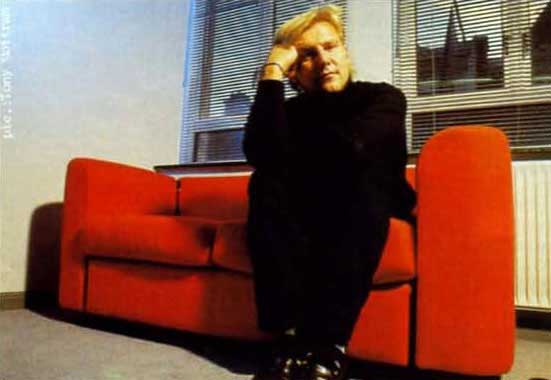
The 'Grace Under Pressure' tour started in the States in May, and Rush found themselves going to Japan during the course of '84, where the band also found it easy to sell out large arenas.
Rush headlined two large open air festivals in Texas that June. Although these shows were the largest ever for the band, playing in front of 120,000 fans in all, the musicians didn't particularly enjoy the stadium atmosphere.
"Open air festivals aren't really our kind of thing", Alex explained to me later. "We feel more at ease in Halls, because of the closer contact with our fans. We've received quite a few offers to play festivals like the Monsters Of Rock. but I don't think we ever will."
Two Rush shows were filmed in September in Canada. and they were released on video under the title 'Grace Under Pressure Tour'. The whole thing was produced in a more complicated fashion than the first live video and is highly recommended to all Rush fans - especially as the band haven't been a frequent sight on European stages recently!
During the following months Rush started collecting material for their new album, an album that was going to be more melodic than 'Grace Under Pressure'. The band chose Peter Collins to produce it, and he did a job achieving a very transparent sound. 'Power Windows' was the title of the album, partly reocrded in the UK and released towards the end of '85. Part of the keyboards were played by Andy Richards, a well-known musician in rock and pop circles, who had also worked with the band Frankie Goes To Hollywood. On the record one could also hear a classical orchestra and a 25-piece choir.
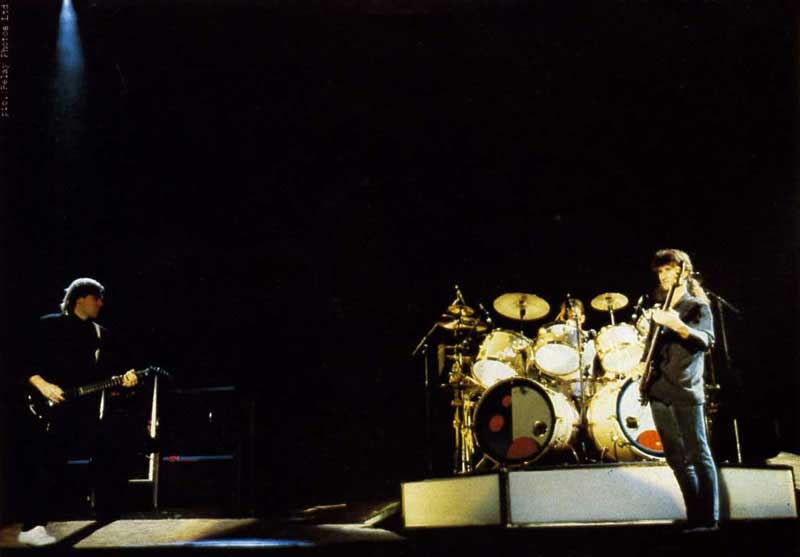
As it is pretty difficult to reproduce such sound elements live, Rush increasingly applied samples during the 'Power Windows' tour, that started in December '85 and ended in May '86. Various shows were recorded, some of them were later released on the third live double album 'A Show Of Hands'.
Work for the twelfth studio LP 'Hold Your Fire' commenced in September, again produced by the band in collaboration with Peter Collins. The album, including my personal highlights the opening track 'Force Ten' and 'Turn the Page' which relies on Geddy's excellent bass playing, featured an unusual variety of styles including everything from a slow orchestral track to an uncomplicated rock song. One could say that 'Hold Your Fire' was a concept album, at least as far as the lyrics are concerned. Says Alex: "Songs like 'Force Ten', 'Open Secrets' and 'Lock And Key' are about human instincts such as motivation and fear. Another subject on the LP is time; 'Time Stand Still' for example expresses the wish to be able to stop time, so as to enjoy certain moments and situations."
Fire
'Hold Your Fire' was released in September '87. and went platinum twice in Canada. Rush started their most recent tour in September '87, lasting until May '88, at last bringing the threesome back to Europe, even [if] it was only for ten dates.
A small consolation for the short stay in Europe was the release of the third double live album 'A Show Of Hands' in January '89. Most of the recordings had been made during the 'Hold Your Fire' tour; only 'Mystic Rhythms' and 'Witch Hunt' had been laid down on tape during the 'Power Windows' tour in New Jersey. 'A Show Of Hands' marked the end of an era within the bands history, in the same way as the two previous live LP's 'All The World's A Stage' and 'Exit...Stage Left' had done. Neil described it as follows: "After we'd been through numerous technical experiments, it was time to transfer the gained experiences onto songs. So we concentrated mainly on arranging the music more effectively. and including different style influences. 'Signals', 'Grace Under Pressure', 'Power Windows' and 'Hold Your Fire' are the result of experiments we did in the past."
Parallel to the third live Opus, a video was released also titled 'A Show Of Hands' that had been filmed during the last European tour in Birmingham, and is also available as a CDV.
So now we've reached January 1989 and the start of a new chapter in the long history of Rush. What can we expect from the future?
"For me, the future is what's happening now" laughed Neil. "I don't know myself what could be happening to Rush in the next two or three years. The only thing I can tell you is that we'll be composing new songs during the next six months. That's what l'm spending all my energy on at present, everything after that can only be seen in the stars..."
Finally a tip for all Rush fanatics: If you can't track down enough info about your fave band, check out the fanzine 'The Spirit Of Rush', costing one pound fifty an issue (including p'n'p, payable by check or P.O.) and available at the following address: Mick Burnett 26 Berwick Tower Knoyle Street New Cross London SE14 6EY England